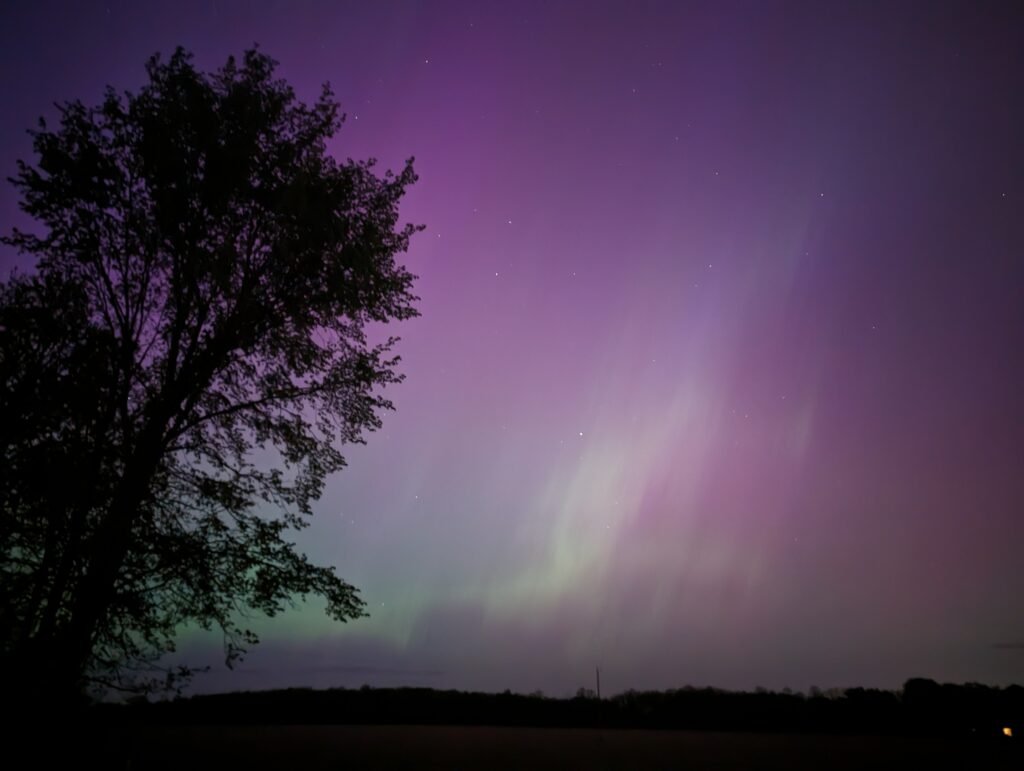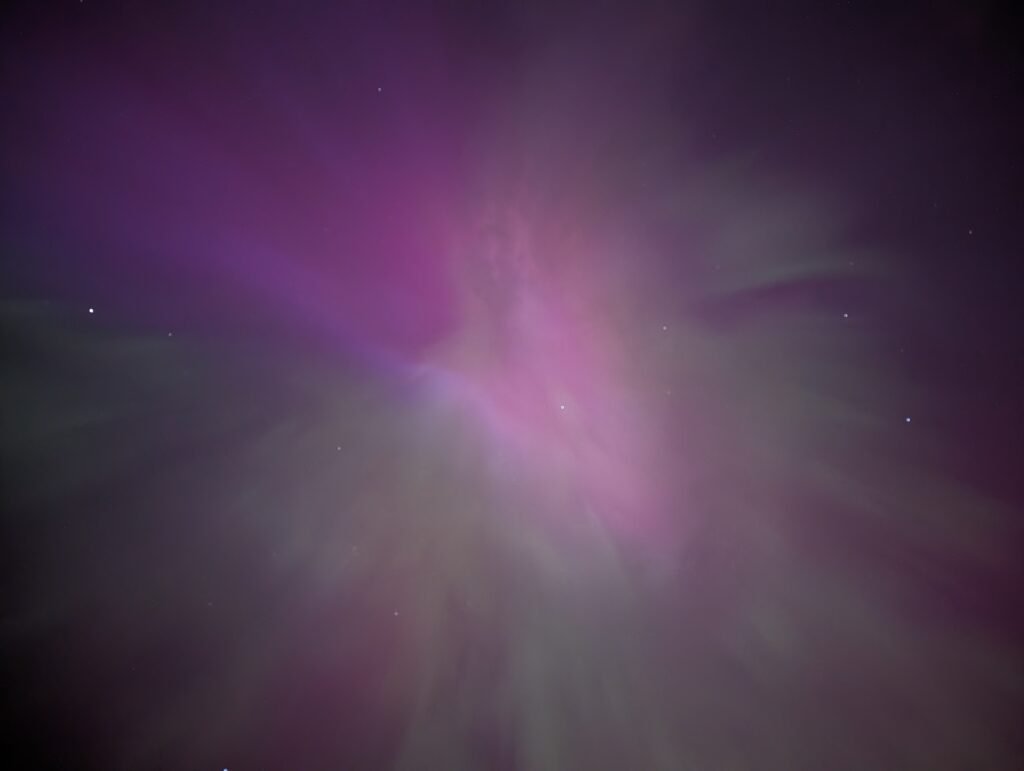
Sunspots, Solar Flares, & CMEs
In Part I of this series, we discovered the Sun emits more than just visible light.
The outermost portion of the Sun – the corona – becomes so hot that particles gather enough kinetic energy to escape the star’s gravity. As these masses flee the Sun, they become the solar wind, moving at approximately 1 million miles per hour, painting the solar system’s boundaries by carrying the Sun’s magnetic field to the heliopause.
Like visible light and other forms of electromagnetic radiation from the Sun, the solar wind constantly “blows.” Earth’s magnetic field shields us from most of the solar wind’s particles, but the nature of the field provides a beautiful side effect. Shaped like a giant bar magnet sticking out of the north and south poles, the field drags some particles from the wind into our atmosphere. When the ionized particles of the solar wind collide with particles in our atmosphere, we get a light show known as an aurora. This interaction is why the phenomenon tends to happen in specific spots, such as Scandinavia or Antarctica, and it’s why we call them northern and southern lights. If one wants to experience an aurora on Earth, Iceland, Norway, Sweden, Finland, Russia, and Canada are one’s best bets, as they reside in what astrophysicists call the auroral zone. And, since the solar wind always blows, one can travel to those places at almost any point and have a decent shot at a display.

Visible light and the solar wind might be the two most vital emissions from the sun, but they aren’t the only flavor of ejections from our star.
The Sun spews neutrinos and, theoretically, gravitational waves, but these happenings are a topic for another article. Recently, the Sun treated a large swath of North America to the northern lights, including many areas far south of the typical auroral zone. If the solar wind is a relatively constant stream and Earth’s magnetic field tends to funnel the particles that reach us into the far reaches of the globe, why did the aurora borealis grace much of the contiguous United States in May 2024?
As we alluded to in the previous article, sometimes the Sun gets a little naughty and belches its innards in a fashion beyond the typical solar wind.
The Sun features a gargantuan nuclear fusion furnace at its core, but the star is not only a metronomic burning machine. Magnetic fluctuations transpire in the Sun’s goop beyond levels we can really comprehend and in ways we don’t fully understand. Sometimes, for example, gigantic black blotches appear on the photosphere, also known as the Sun’s surface.
We call these areas sunspots.


These blobs are temporary, and, as you might have guessed because of their coloration, they are cooler than the other spots on the photosphere. Magnetic flux on the Sun’s surface hampers convection, which is the main method of heat transfer above the radiative zone in the Sun’s layer hierarchy, causing a temperature drop in that region.
Sunspots vary wildly in size, with diameters of approximately 10 miles in the smallest spots and 100,000 miles – four times the circumference of the Earth! – for the largest. The biggest monsters can be seen by the naked human eye! Their temporality also varies, as sunspots can persist for just a few days or up to several months.
Over time, sunspots can move and morph, before eventually collapsing. As with many features of the Sun, we do not completely understand the underpinnings of sunspots, though the progress we have made is nothing short of astonishing. Scientists now believe they form thanks to magnetic flux tubes, a phenomenon that sounds more like science fiction than fact. In 2001, the European Space Agency’s Solar and Heliospheric Observatory used sound waves to construct a three-dimensional image of the structure beneath a sunspot. Underlying the splotches are rotating vortices and potent downdrafts, something akin to whirlpools made of solar plasma. As incredible as this structure is, the fact that humans were able to image a sunspot’s guts a quarter of a century ago is almost more mind-blowing.

Sunspots, on their own, have little effect on Earth. However, they tend to be omens to the enterprising solar meteorologist. The phenomenon occurs in zones called active regions. The term applies to areas of high and complex magnetic activity. When astronomers spy sunspots, they indicate an active region, which means a pair of other solar emissions might soon materialize.
Magnetic fields are bizarre entities. When they are in flux, they can “bend,” “snap,” or “reconnect.” These reconnections seem to be explosive events. On the Sun, the results of these reconnections are solar flares and coronal mass ejections (CMEs). The difference between these explosions mirrors the difference between the Sun’s visible light and the solar wind; one is composed of electromagnetic radiation (solar flares) and the other is matter in plasma form (CMEs).
Solar flares are localized, fierce emissions of electromagnetic radiation. Though the pulses produce the entire spectrum of radiation, they specialize in X-rays and ultraviolet rays. Flares often occur in relatively short bursts (minutes to hours), making them the fireworks of the Sun.

Despite the foreboding nature of X-rays and ultraviolet rays shooting at our planet, Earth does a swell job at mitigating the issue. The ionosphere does not allow any of the dangerous rays to reach the surface of Earth. However, solar flares can disrupt short-wave radio communication and pose minor threats to astronauts and satellites.
The other emission from active regions, however, can bring myriad problems to Earth.
Coronal mass ejections do not spew massless photons but massive plasma. The “massive” modifier in the preceding sentence serves double duty. The plasma takes the form of literal mass (i.e. particles of elements) and the ejections are behemoth. The average CME injects 3.5×1012 pounds of mass into the stream of the solar wind.
If these particles head toward Earth, bad things can happen. If the speed of the ejection surpasses the speed of the ambient solar wind, the shock wave creates a geomagnetic storm. These waves are so powerful that they morph the shape of the Earth’s magnetic field. Particularly large CMEs can breach the Earth’s magnetic defenses, wreaking havoc on electronics and power grids. A CME in 1989 knocked out the Hydro-Québec power grid, leaving millions without electricity. When you hear about potential doomsday electronic events, CMEs will be the likely culprit.
Not everything is negative with CMEs, though.
Coronal mass ejections can lead to phenomenal auroras. Unlike the normal solar wind, CMEs can treat those of us who don’t live in the auroral zone to the phenomenon.
The Sun runs on 11-year cycles, during which solar activity ebbs and flows. The year 2024 coincided with a solar maximum, which meant a heightened number of sunspots, flares, and CMEs. Preceding the auroral activity of May 2024, a monumental sunspot appeared, visible to humans without telescopes. Heliophysicists scanned the skies for solar activity. Since photons comprise solar flares, they reach Earth in the same eight-minute intervals as normal visible light. We catch flares as they arrive. CMEs, on the other hand, travel much more slowly. An array of satellites sits at the L1 Lagrange point, a special spot between Earth and the Sun that allows for gravitational equilibrium. Since the solar wind travels slower than the speed of light, these satellites can detect CMEs heading toward Earth and then beam the information to us at light speed, allowing us to predict auroral activity. In the hours leading up to the auroras of 17 and 18 May 2024, scientists successfully alerted earthlings to a gorgeous light show.
Humans across the United States watched the sky dance, in many spots usually foreign to aurora.





These southern versions of the northern lights are subtle reminders about the raw power of the universe. We can thank the CME for painting these skies, but the Sun can easily turn from artist to destroyer.
Our reliance on electronics and satellites leaves us vulnerable to nasty solar storms. Even though we have not yet faced an electronic problem on a global scale from CMEs, this notion is far from fantastical sci-fi. We don’t have to go too far into the history books to watch what happens when the sun brings the metaphorical heat.
As we’ll see in Part III, sometimes the Sun can get so frisky that the sky itself can provide electricity!
Further Reading and Exploration
Sunspots and Solar Flares – NASA Space Place
The Sun and Sunspots – NOAA
SOHO reveals how sunspots take stranglehold on the Sun – Spaceflight Now
What is a Solar Flare? – NASA
CORONAL MASS EJECTIONS – NASA Space Weather Prediction Center
Coronal mass ejections: What are they and how do they form? – Space
How a giant sunspot unleashed solar storms that spawned global auroras that just dazzled us all – Space













